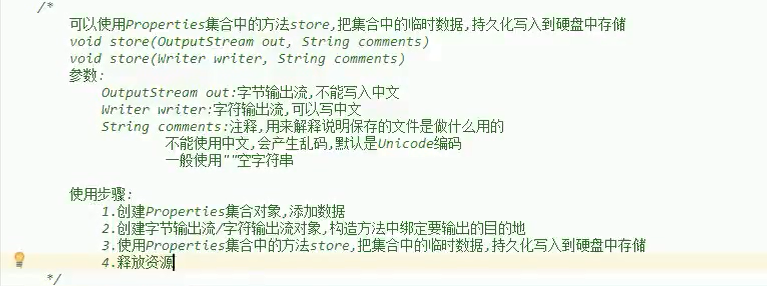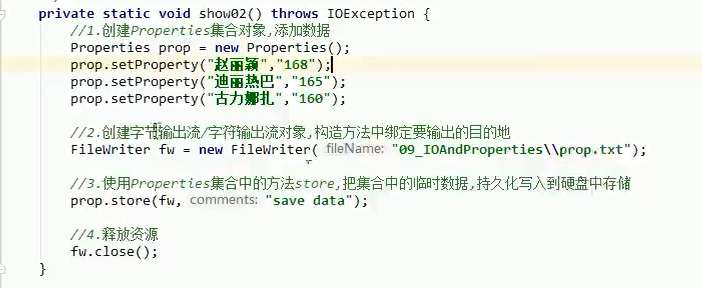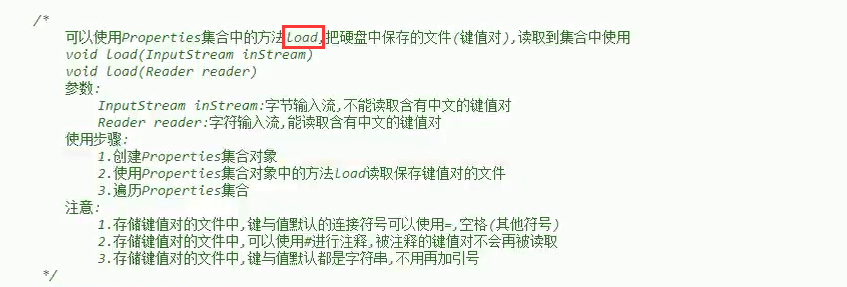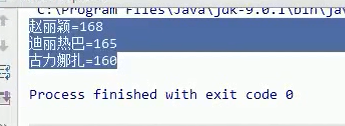1_使用Properties集合存储数据,遍历






输出结果:

(2)load



修改空格为键与值的分隔符

执行结果:

-------------------------------------------------------------------------------------------------------------------------------------------------------------------------
Demo01Properties.java
package com.itheima.demo07.Prop;
import java.io.FileOutputStream;
import java.io.FileReader;
import java.io.IOException;
import java.util.Properties;
import java.util.Set;
/*
java.util.Properties集合 extends Hashtable<k,v> implements Map<k,v>
Properties 类表示了一个持久的属性集。Properties 可保存在流中或从流中加载。
Properties集合是一个唯一和IO流相结合的集合
可以使用Properties集合中的方法store,把集合中的临时数据,持久化写入到硬盘中存储
可以使用Properties集合中的方法load,把硬盘中保存的文件(键值对),读取到集合中使用
属性列表中每个键及其对应值都是一个字符串。
Properties集合是一个双列集合,key和value默认都是字符串
*/
public class Demo01Properties {
public static void main(String[] args) throws IOException {
show03();
}
/*
可以使用Properties集合中的方法load,把硬盘中保存的文件(键值对),读取到集合中使用
void load(InputStream inStream)
void load(Reader reader)
参数:
InputStream inStream:字节输入流,不能读取含有中文的键值对
Reader reader:字符输入流,能读取含有中文的键值对
使用步骤:
1.创建Properties集合对象
2.使用Properties集合对象中的方法load读取保存键值对的文件
3.遍历Properties集合
注意:
1.存储键值对的文件中,键与值默认的连接符号可以使用=,空格(其他符号)
2.存储键值对的文件中,可以使用#进行注释,被注释的键值对不会再被读取
3.存储键值对的文件中,键与值默认都是字符串,不用再加引号
*/
private static void show03() throws IOException {
//1.创建Properties集合对象
Properties prop = new Properties();
//2.使用Properties集合对象中的方法load读取保存键值对的文件
prop.load(new FileReader("09_IOAndProperties\\prop.txt"));
//prop.load(new FileInputStream("09_IOAndProperties\\prop.txt"));
//3.遍历Properties集合
Set<String> set = prop.stringPropertyNames();
for (String key : set) {
String value = prop.getProperty(key);
System.out.println(key+"="+value);
}
}
/*
可以使用Properties集合中的方法store,把集合中的临时数据,持久化写入到硬盘中存储
void store(OutputStream out, String comments)
void store(Writer writer, String comments)
参数:
OutputStream out:字节输出流,不能写入中文
Writer writer:字符输出流,可以写中文
String comments:注释,用来解释说明保存的文件是做什么用的
不能使用中文,会产生乱码,默认是Unicode编码
一般使用""空字符串
使用步骤:
1.创建Properties集合对象,添加数据
2.创建字节输出流/字符输出流对象,构造方法中绑定要输出的目的地
3.使用Properties集合中的方法store,把集合中的临时数据,持久化写入到硬盘中存储
4.释放资源
*/
private static void show02() throws IOException {
//1.创建Properties集合对象,添加数据
Properties prop = new Properties();
prop.setProperty("赵丽颖","168");
prop.setProperty("迪丽热巴","165");
prop.setProperty("古力娜扎","160");
//2.创建字节输出流/字符输出流对象,构造方法中绑定要输出的目的地
//FileWriter fw = new FileWriter("09_IOAndProperties\\prop.txt");
//3.使用Properties集合中的方法store,把集合中的临时数据,持久化写入到硬盘中存储
//prop.store(fw,"save data");
//4.释放资源
//fw.close();
prop.store(new FileOutputStream("09_IOAndProperties\\prop2.txt"),"");
}
/*
使用Properties集合存储数据,遍历取出Properties集合中的数据
Properties集合是一个双列集合,key和value默认都是字符串
Properties集合有一些操作字符串的特有方法
Object setProperty(String key, String value) 调用 Hashtable 的方法 put。
String getProperty(String key) 通过key找到value值,此方法相当于Map集合中的get(key)方法
Set<String> stringPropertyNames() 返回此属性列表中的键集,其中该键及其对应值是字符串,此方法相当于Map集合中的keySet方法
*/
private static void show01() {
//创建Properties集合对象
Properties prop = new Properties();
//使用setProperty往集合中添加数据
prop.setProperty("赵丽颖","168");
prop.setProperty("迪丽热巴","165");
prop.setProperty("古力娜扎","160");
//prop.put(1,true);
//使用stringPropertyNames把Properties集合中的键取出,存储到一个Set集合中
Set<String> set = prop.stringPropertyNames();
//遍历Set集合,取出Properties集合的每一个键
for (String key : set) {
//使用getProperty方法通过key获取value
String value = prop.getProperty(key);
System.out.println(key+"="+value);
}
}
}

来源:https://www.cnblogs.com/curedfisher/p/12484224.html